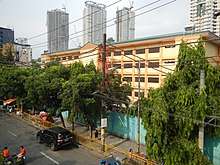Education in the Philippines during Spanish rule
During the Spanish colonial period in the Philippines (1521–1898), the different cultures of the archipelago experienced a gradual unification from a variety of native Asian and Islamic customs and traditions, including animist religious practices, to what is known today as Filipino culture, a unique hybrid of Southeast Asian and Western culture, namely Spanish, including the Spanish language and the Catholic faith.
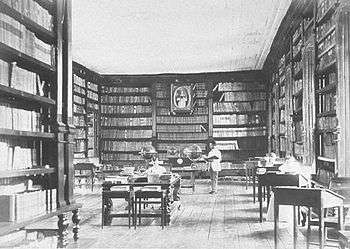
Spanish education played a major role in that transformation. The oldest universities, colleges, and vocational schools, dating as far back as the late 16th century were created during the colonial period, as well as the first modern public education system in Asia, established in 1863. By the time Spain was replaced by the United States as the colonial power, Filipinos were among the most educated peoples in all of Asia, boasting one of the highest literacy rates in that continent. Simultaneously, the knowledge of Filipinos about neighboring cultures receded.[1]
The early period
During the early years of Spanish colonization, education was mostly run by the Church. Spanish friars and missionaries educated the natives and converted indigenous populations to the Catholic faith.
King Philip II's Leyes de Indias (Laws of the Indies) mandated Spanish authorities in the Philippines to educate the natives, to teach them how to read and write in the Spanish language. However, the latter objective was difficult given the realities of the time.[2] The early friars learned the local languages to better communicate with the locals. Although by royal decree the friars were required to teach the Spanish language to the natives, they realized it would be easier for them to learn the local languages first, before teaching Spanish to the population.
The Spanish missionaries established schools soon after reaching the islands and a few decades into the Spanish period, there was no Christian village without its school, with most children attending.
The Augustinians opened a school immediately upon arriving in Cebú in 1565. The Franciscans arrived in 1577, and they, too, immediately taught the people how to read and write, besides imparting to them important industrial and agricultural techniques. The Jesuits who arrived in 1581 also concentrated on teaching the young. When the Dominicans arrived in 1587, they did the same thing in their first mission in Bataan.[3]
Within months of their arrival in Tigbauan which is in Iloilo province located in the island of Panay, Pedro Chirino and Francisco Martín had established a school for Visayan boys in 1593 in which they taught not only the catechism but reading, writing, Spanish, and liturgical music. The Spaniards of Arévalo heard of the school and wanted Chirino to teach their boys too. Chirino at once put up a dormitory and school house (1593–1594) for the Spanish boys near his rectory. It was the first Jesuit boarding school to be established in the Philippines.[4][5]
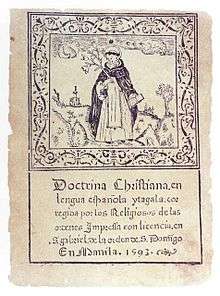
The Chinese language version of the Doctrina Christiana (Christian Doctrine) was the first book printed in the Philippines in about 1590 to 1592. A version in Spanish, and in Tagalog, in both Latin script and the commonly used Baybayin script of the Manila Tagalogs of the time was printed in 1593.[6] The goal to teach the Christian faith to the literate population. Eventually, the Baybayin script was replaced by the Latin script, as this became increasingly more useful and widespread.[7]
In 1610,Tomas Pinpin a Filipino printer, writer and publisher, who is sometimes referred as the "Patriarch of Filipino Printing", wrote his famous Librong Pagaaralan nang manga Tagalog nang Uicang Castilla, that was meant to help Filipinos learn the Spanish language. The prologue read:
Let us therefore study, my country men, for although the art of learning is somewhat difficult, yet if we are persevering, we shall soon improve our knowledge.
Other Tagalogs like us did not take a year to learn the Spanish language when using my book. This good result has given me satisfaction and encouraged me to print my work, so that all may derive some profit from it.[8]
There were also Latin schools where that language was taught together with some Spanish, since it was a mandatory requirement for the study of philosophy, theology and jurisprudence in schools like the University of Santo Tomás, run by the Dominicans. The Philippine priests and lawyers of that time, with the exception of the sons and daughters of Spaniards, Principalías and Ladinos,[9][n 1] knew Latin perfectly well because the educational system was wholly religious.
The friars also opened many medical and pharmaceutical schools. The study of pharmacy consisted of a preparatory course with subjects in natural history and general chemistry and five years of studies in subjects such as pharmaceutical operations at the school of pharmacy. At the end of this period, the degree of Bachiller en Farmacia was granted.
By the end of the 16th century, several religious orders had established charity hospitals all over the archipelago and provided the bulk of this public service. These hospitals also became the setting for rudimentary scientific research work on pharmacy and medicine, focusing mostly on the problems of infections diseases. Several Spanish missionaries cataloged hundreds of Philippine plants with medicinal properties. The Manual de Medicinas Caseras...., written by Father Fernando de Santa María, first published in 1763,[10] became so sought after that it was reprinted on several editions by 1885.
Colegio de Santa Potenciana was the first school and college for girls that opened in the Philippines, in 1589. It was followed by another school for women, Colegio de Santa Isabel, that opened in 1632. Other Schools and Colleges for girls were Santa Catalina, Santa Rosa, La Concordia, etc. Several religious congregations also established schools for orphaned girls who could not educate themselves.[11]
Tertiary schools
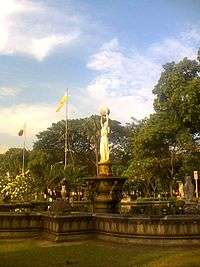
In 1590, the Universidad de San Ignacio was founded in Manila by the Jesuits, initially as the Colegio-Seminario de San Ignacio. By the second half of the 17th century, the university was incorporated as a mere College of Medicine and Pharmacy into the University of Santo Tomás.[12]
The Colegio de San Ildefonso was established in 1595 in Cebú by the Society of Jesus. The school closed down in 1768, but the present-day University of San Carlos makes the claim of tracing its roots to the arguably defunct 16th Century school. This claim has been the subject of numerous debates.
On April 28, 1611, the Universidad de Santo Tomás was founded in Manila, initially named as the Colegio de Nuestra Señora del Santísimo Rosario and later renamed as Colegio de Santo Tomas. [n 2] On November 20, 1645, Pope Innocent X elevated it to University. King Charles III of Spain bestowed the title "Royal" in 1785, and Pope Leo XIII "Pontifical" in 1902. Pope Pius XII designated it as La Real y Pontificia Universidad de Santo Tomás de Aquino Universidad Católica de Filipinas (The Catholic University of the Philippines), in 1947.[12]
In 1640, the Universidad de San Felipe de Austria was established in Manila. It was the first public university created by the Spanish government in the Philippines. It closed down in 1643.[12]
The Jesuits also founded the Colegio de San José (1601) and took over the management of a school that became the Escuela Municipal (1859, later renamed Ateneo Municipal de Manila in 1865, now the Ateneo de Manila University). The Dominicans on their part had the Colegio de San Juan de Letrán (1620) in Manila. All of them provided courses leading to different prestigious degrees, like the Bachiller en Artes, that by the 19th century included science subjects such as physics, chemistry, natural history and mathematics. The University of Santo Tomás, for example, started by teaching theology, philosophy and humanities. During the 18th century, the Faculty of Jurisprudence and Canonical Law was established.
In 1871, several schools of medicine and pharmacy were opened. From 1871 to 1883 Santo Tomás alone had 829 registrations of medical students, and from 1883 until 1898, 7965 medical students. By the end of the Spanish colonial rule in 1898. the university had granted the degree of Licenciado en Medicina to 359 graduates and 108 medical doctors. For the doctorate degree in medicine its provision was inspired in the same set of oppositions than those of universities in the metropolis, and at least an additional year of study was required at the Universidad Central de Madrid in Spain.
Dispute over the oldest in the Philippines
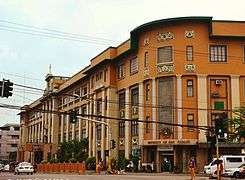
The title of the oldest in the Philippines have been topic for debate between two educational institutions: the University of Santo Tomas and the University of San Carlos.[15]
The University of Santo Tomas, established in 1611 as the Colegio de Nuestra Señora de Santisimo Rosario, is generally recognized as the oldest university in the Philippines. In 1935 the Commonwealth government of the Philippines through the Historical Research and Markers Committee declared that UST was "oldest university under the American flag."[16] In the 1990s, the Intramuros Administration installed a marker on the original site of the University of Santo Tomas with the recognition that the university is the "oldest university in Asia."[17] In 2011 Pope Benedict XVI recognized UST as "the oldest institution of Catholic higher education in the Far East,"[18] while in 2012 the National Historical Commission of the Philippines published an online article recognizing UST as "Asia's Oldest University.[19]
However, the University of San Carlos has opposed this recognition and claims that it is older than the University of Santo Tomas by 16 years by tracing its roots to the Colegio de San Ildefonso (established 1595).[20] In 1995, the University of San Carlos celebrated its Quadricentennial (400th Anniversary).[21]
Numerous scholars and official government bodies have reviewed the case. In 2010, the National Historical Commission of the Philippines installed a bronze marker declaring USC's foundation late in the 18th Century, effectively disproving any direct connection with the Colegio de San Ildefonso.[22] According to Dr. Victor Torres of the De La Salle University, the University of San Carlos' claim dates back to 1948 only when USC was declared a University.[21] Fidel Villarroel from the University of Santo Tomas argued that USC only took over the facility of the former Colegio de San Ildefonso and that there is no 'visible' and 'clear' link between San Carlos and San Ildefonso.[23] Aloysius Cartagenas (a Cebuano), in a paper published by Philippiniana Sacra, stated that the correct foundation year of USC is 1867, and not 1595,[24] while in 2012 the National Historical Commission of the Philippines cemented its previous position when it published an online article recognizing UST as "Asia's Oldest University.[19]
Secondary schools
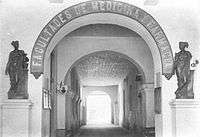
A Nautical School was created on January 1, 1820 which offered a four-year course of study (for the profession of pilot of merchant marine) that included subjects such as arithmetic, algebra, geometry, trigonometry, physics, hydrography, meteorology, navigation and pilotage. A School of Commercial Accounting and a School of French and English Languages were established in 1839.
The Don Honorio Ventura College of Arts and Trades (DHVCAT) in Bacolor, Pampanga is said to be the oldest official vocational school in Asia. Augustinian Friar Juan Zita and civic leader Don Felino Gil established the vocational school on November 4, 1861. Other important vocational schools established were the Escuela de Contaduría, Academia de Pintura y Dibujo and the seminaries of Manila, Nueva Segovia, Cebú, Jaro and Nueva Cáceres.[25]
The Manila School of Agriculture was created in 1887, although it was unable to open its doors until July 1889. Its mission was to provide theoretical and practical education by agricultural engineers to skilled farmers and overseers, and to promote agricultural development by means of observation, experiment and investigation. It included subjects such as mathematics, physics, chemistry, natural history, agriculture, topography, linear and topography drawing. Agricultural schools and monitoring stations, run by professors who were agricultural engineers, were also established in Isabela, Ilocos, Albay, Cebú, Iloílo, Leyte and parts of Mindanao.[26]
The Real Sociedad Económica de los Amigos del País de Filipinas (Royal Economic Society of Friends of the Philippines) was first introduced in the islands in 1780, and offered local and foreign scholarships to Filipinos, professorships and financed trips of scientists from Spain to the Philippines. Throughout the nineteenth century the Society established an academy of design, financed the publication of scientific and technical literature, and granted awards to successful experiments and inventions that improved agriculture and industry.[27]
The Observatorio Meteorológico del Ateneo Municipal de Manila (Manila Observatory) was founded in 1865 by the Jesuits after an article they published in the newspaper Diario de Manila, describing typhoon observations made in September 1865, attracted the attention of many readers who publicly requested for the observations to be continued. The Spanish government made the observatory the official institution for weather forecasting in the Philippines in 1884, and in 1885 it started its time service. Its seismology section was set up in 1887, while astronomical studies began in 1899. The Observatory published typhoon and climatological observations and studies, including the first typhoon warnings, a service that was highly appreciated by the business community, specially those involved in merchant shipping.[28]
Modern public system of education
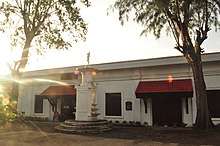
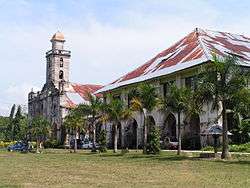
Modern public school education was introduced in Spain in 1857.[33] This did not exist in any other colony of any European power in Asia. The concept of mass education was relatively new, an offshoot of the 18th century Age of Enlightenment.[34] France was the first country in the world to create a system of mass, public education in 1833.
In the Philippines, free access to modern public education was made possible through the enactment of the Spanish Education Decree of December 20, 1863 by Queen Isabella II. Primary instruction was made free and the teaching of Spanish was compulsory.[35] This was ten years before Japan had a compulsory form of free modern public education and forty years before the American government started an English-based public school system in the Philippines.[2] The royal decree provided for a complete educational system consisting of primary, secondary and tertiary levels, resulting in valuable training for all Filipino children and youth.[36]
The Education Decree of 1863 provided for the establishment of at least two free primary schools, one for boys and another for girls, in each town under the responsibility of the municipal government. It also commended the creation of a free public normal school to train men as teachers, supervised by the Jesuits. One of these schools was the Escuela Normal Elemental, which, in 1896 became the Escuela Normal Superior de Maestros de Manila (The Normal School) for male teachers. The Spanish government also established a School for midwives in 1879, and a Normal School for female teachers in 1892, the Escuela Normal Superior de Maestras.[37] By the 1890s, free public secondary schools were opening outside of Manila, including 10 normal schools for women.[38]
The range of subjects being taught were very advanced, as can be seen from the Syllabus of Education in the Municipal Atheneum of Manila, that included Algebra, Agriculture, Arithmetic, Chemistry, Commerce, English, French, Geography, Geometry, Greek, History, Latin, Mechanics, Natural History, Painting, philosophy, Physics, Rhetoric and poetry, Spanish Classics, Spanish Composition, Topography, and Trigonometry. Among the subjects being taught to girls, as reflected in the curriculum of the Colegio de Santa Isabel, were Arithmetic, Drawing, Dress-cutting, French, Geology, Geography, Geometry, History of Spain, Music, Needlework, Philippine History, Physics, Reading, Sacred History and Spanish Grammar.[11]
Contrary to what the Propaganda of the Spanish–American War tried to depict, the Spanish public system of education was open to all the natives, regardless of race, gender or financial resources. The Black Legend propagation, black propaganda and yellow journalism were rampant in the last two decades of Spanish Colonial Period[39][40] and throughout the American Colonial Period.[n 3][n 4] Manuel L. Quezon, on his speech for the Philippine Assembly at the US Congress in October 1914 stated that [n 5]
...there were public schools in the Philippines long before the American occupation, and, in fact, I have been educated in one of these schools, even though my hometown is such a small town, isolated in the mountains of the Northeastern part of the island of Luzon.[41]
...as long ago as 1866 when the total population of the Philippine Islands was only 4,411,261 souls, and when the total number of municipalities in the archipelago was 900, the total public schools was 841 for boys and 833 for girls and the total number of children attending these schools was 135,098 for boys and 95,260 for girls. And these schools were real buildings and the pupils alert, intelligent, living human beings. In 1892, the number of schools had increased to 2,137, of which 1,087 were for boys and 1,050 for girls. I have seen with my own eyes many of these schools and thousands of these pupils. They were not religious schools, but schools created, supported and maintained by the Government (Spanish).[42][43]
Gunnar Myrdal, a renowned Swedish economist, observed that in 19th-century Asia, Japan and Spanish Philippines stood out because of their stress on modern public education.[2][33]
Education and Filipino nationalism
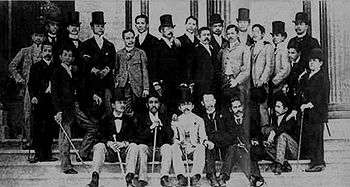
As a result of increasing the number of educated Filipinos a new social class raised, that came to be known as the Ilustrados. Furthermore, with the opening of Suez Canal in 1869 travel to Spain become quicker, easier and more affordable, and many Filipinos took advantage of it to continue higher education in Spain and Europe, mostly in Madrid and Barcelona. This new enlightened class of Filipinos would later lead the Philippine independence movement, using the Spanish language as their main communication method. The most prominent of the Ilustrados was José Rizal, who inspired the desire for independence with his novels written in Spanish. Other Filipino intellectuals, such as Graciano López Jaena, Marcelo H. del Pilar, Mariano Ponce or Antonio Luna, who had also studied in Spain, began contributing to the cause for Filipino self-government and independence.[44]
Describing this new generation of highly educated Filipinos, Fr. John N. Schumacher pointed out that,
Philippine higher education was not far behind, or, under certain aspects, was even superior to the general level of higher education in Spain, at least outside Madrid. Perhaps the best testimony for this is the fact that such larger numbers of Filipino students were able to move without apparent difficulty from educational institutions at home to those in the Peninsula and establish honorable records for themselves there.[45]
The Philippines was also ahead of some European countries in offering education for women.[34] Ironically, it was during the time of American occupation of the Philippines that the results of Spanish education were more visible, especially in the literature, printed press and cinema.[46]
Criticisms
On November 30, 1900, the Philippine Commission reported to the US War Department about the state of education throughout the archipelago as follows:
...Under Spanish rule there were established in these islands a system of primary schools. The Spanish regulations provided that there should be one male and one female primary school-teacher for each 5,000 inhabitants. It is clearly shown in the report of the first Philippine Commission that even this inadequate provision was never carried out. They say: "Taking the entire population at 8,000,000, we find that there is but one teacher to each 4,179 inhabitants." There were no schoolhouses, no modern furniture, and, until the Americans came, there were no good text-books. The schools were and are now held in the residences of the teachers, or in buildings hired by the municipalities and used by the principals as dwellings. In some of the schools there were wooden benches and tables, but it was not at all unusual to find a school without any seats for the pupils. In these primary schools, reading, writing, sacred history, and the catechism were taught. Except in a very few towns, the four elementary arithmetical processes were attempted, and in a few towns a book on geography was used as a reading book. Girls were taught embroidery and needlework. From the beginning the schools were entirely under the supervision of the religious orders, who were disposed to emphasize secondary and higher education for a few pupils rather than to further and promote the primary education of the masses. The result of this policy is that a few persons have stood out prominently as educated Filipinos, while the great mass of people have either not been educated at all or furnished only the rudiments of knowledge, acquiring merely the mechanical processes of reading and writing. The little school instruction the average Filipino has had has not tended to broaden his intelligence or to give him power of independent thought. One observes in the schools a tendency on the part of the pupils to give back, like phonographs, what they have heard or read or memorized, without seeming to have thought for themselves. As a rule, they possess mechanical skill, and they excel in writing and drawing. The Spaniards made very little use of this peculiar capacity.
...It is stated on good authority that when the Spaniards came here several of the tribes of the Philippine Islands could read and write their own language. At the present time, after three hundred years of Spanish domination, the bulk of the people cannot do his. The Spanish minister for the colonies, in a report made December 5, 1870, points out that, by the process of absorption, matters of education had become concentrated in the hands of the religious orders. He says: "While every acknowledgement should be made of their services in earlier times, their narrow, exclusively religious system of education, and their imperviousness to modern or external ideas and influences, which every day become more and more evident, rendered secularization of instruction necessary."
...It has been stated that in 1897 here were in these islands 2,167 public schools. The ineffectiveness of these schools will be seen when it is remembered that a school under the Spanish regime was a strictly sectarian, ungraded school, with no prescribed course of study and no definite standards for each year, and that they were in charge of duly certificated but hardly professionally trained or progressive teachers, housed in unsuitable and unsanitary buildings.[47]
Those numbers led some people to conclude that less than 6% of the population were attending schools. However that assumption was misleading because it is calculated based on the entire population, including babies and senior citizens, when in reality public school systems are meant primarily for children and teenagers. In order to calculate the percentage of children attending schools, the number of children of school age must be used, including those of Elementary School age (ages 5 through 13) and teenagers in High School age (ages 14 through 17). That would yield a total percentage of around 20% of the total population. Since the 1887 census yielded a count of 6,984,727,[48] 20% would be approximately 1,4 million. Also, by 1892 the number of schools had more than doubled to 2,137, 1,087 of which were for boys and 1,050 for girls, which means that the number of children attending school also did increase, to at least 500,000, by conservative estimates. That's about 35% of the population in School age.
Another claim commonly heard was that based on the official figures there couldn't be a school in every village in the Islands, as Manuel L. Quezon declared years later before the Philippine Assembly. However, since those official figures branded by the Philippine Commission itself put the total number of municipalities in the archipelago at 900, and the number of public schools at 2,167, those numbers reveal that there was not only one school in every municipality in the Islands, but in most cases two or more.
Neither was taken into account that the schools maintained by Spain were closed and in many cases looted and badly damaged during the Spanish–American War and the Philippine Revolution. Although the free and compulsory elementary education system was temporarily reestablished by the Malolos Constitution, it was finally dismantled after the Philippine–American War, that also took a heavy toll upon the remaining educational infrastructures.
Finally, the Philippine Commission made no reference to the fact that the pioneering public school education introduced by Spain in the Philippines was the first of its kind in all of Asia, and the first to be established in any European colony in the world. Such system was even ahead of most of United States at the time, where by 1900 only 34 states had any kind of compulsory schooling laws requiring attendance until age 14.[49] As a result, the average American at the time was less educated than the average Filipino, something that was specially true among the troops that fought in the Philippine–American War, since most of the soldiers generally were of humble social origins.[50]
See also
- Education in the Philippines
- Education in the Philippines during United States rule
- Department of Education (Philippines)
- Education in Spain
- Philippine literature in Spanish
- Spanish language in the Philippines
- History of the Philippines
Notes
- Villareal 2006, p. 9, "Ladinos, natives from the Philippines who were the informants, translators, or even better, consultants of the missionaries."
- The University of Santo Tomás is the oldest existing university in Asia Archived December 22, 2009[Date mismatch], at the Wayback Machine from the University's own website.
- Gómez Rivera 2000, "Finally it should make known that all, absolutely all Filipinos who now occupy high positions in the Assembly (House of Representatives of the Philippines) in the Courts, in commerce, in the arts, and in the administration are products of the Spanish education which the Americans and their lackeys here treacherously attack in newspapers and school textbooks at every turn."
- Morrow 2002, "Even the prominent Dr. Henry Otley Beyer wrote in The Philippines before Magellan (1921) that, "one Spanish priest in Southern Luzon boasted of having destroyed more than three hundred scrolls written in the native character." Historians have searched for the source of Beyer's claim, but until now none have even learned the name of that zealous priest. Furthermore, there has never been a recorded instance of ancient Filipinos writing on scrolls. The fact that they wrote on such perishable materials as leaves and bamboo is probably the reason why no pre-Hispanic documents have survived."
- Speech of Manuel L. Quezon, for the Philippine Assembly before the US Congress regarding the Jones Bill, October 1914.
References
- Coleman 2009, pp. 17–59
- Andrade Jr. 2001, p. 1
- Arcilla 1998, p. 50
- "The Jesuits in Tigbauan, Iloilo". goILOILO.com. August 22, 2008. Archived from the original on August 23, 2010. Retrieved August 24, 2010.
- de la Costa 1967
- First book of the Spanish Philippines
- Morrow 2002
- Filipinos in History, National Historical Institute, 1990, p. 102
- Lumbera 2001, pp. 36–39
- de Santa María 1863
- Foreman, John (1906). The Philippine Islands: a political, geographical, ethnographical, social and commercial history of the Philippine Archipelago, embracing the whole period of Spanish rule, with an account of the succeeding American insular government. C. Scribner's sons. p. 194.
- Cruz 2009
- Garcia, F.C. (February 1, 2006). "Remembering our Rectors". The Varsitarian. 77 (9). Retrieved November 9, 2011.
- De Ramos, N.V., 2000. I Walked with Twelve UST Rectors.
- UST, USC engages in friendly debate Today's Carolinian Accessed April 19, 2020
- The Historical Marker Database accessed April 19, 2020
- University of Santo Tomas Intramuros Administration marker Accessed April 23, 2020
- The Papal Message from Pope Benedict XVI to the Pontifical and Royal University of Santo Tomas accessed April 19, 2020
- Asia’s Oldest University, The Royal and Pontifical University of Santo Tomas 'National Historical Commission of the Philippines' accessed April 19, 2020
- About USC 'The University of San Carlos Website' accessed April 19, 2020
- No contest: UST is oldest university 'Philippine Daily Inquirer' Accessed April 19, 2020
- NHCP historical marker for University of San Carlos in Cebu City 'National Historical Commission of the Philippines marker' accessed April 19, 2020
- UST is oldest, period 'The Varsitarian' Accessed April 19, 2020
- Which Is the Oldest University? Revisiting the Conflicting Claims of the University of Santo Tomas,Manila and University of San Carlos, Cebu in Light of the Historyof Seminario (Mayor) de San Carlos of Cebu 'Philippine E-Journals' accessed April 19, 2020
- Quezon 1915, p. 38
- Blair and Robertson. The Philippine Islands, 1493–1898. BiblioBazaar. ISBN 1-4264-8144-6.
- Legarda, Benito (1955). "Foreign Trade, Economic Change and Entrepreneurship in the Nineteenth Century Philippines". Department of Economics, Harvard University, Cambridge, Mass.: 117–119, 321–326.
- "History". Archived from the original on July 17, 2011. Retrieved January 13, 2011.
- Magalang, Konsehal Myke. "Col. Maximo Abad: Exultations and twinges in his life stories". p. 7.
The present branch of the National Museum in Boac was the site of the Escuela de Niños as can be seen in the Historical Marker (see proto above) in the said edifice.
- Jose, Regalado Trota (2001). Visita Iglesia Bohol: A Guide to Historic Churches. National Commission for Culture and the Arts. p. 18. ISBN 9789718140161.
The original twin buildings for the escuela de niños, built in the 1880s under the supervision of the parish priests, still stand to the left of the church.
- "The History of Gen. Gregorio del Pilar Elementary School". Archived from the original on August 14, 2019.
Barely two years after the earthquake of 1863, looking for a place where to establish a schoolhouse, an enterprising Cebuano, Don Guillermo Osmeña, applied and was granted a permit to open the Escuela de Niños y Niñas
- "The History of Gen. Gregorio del Pilar Elementary School". Archived from the original on August 14, 2019.
This school was ungraded and for sons and daughters of "Indios" who could not afford to enroll in the neighboring private school within the arrabales of Sta Cruz, Tondo, Binondo and Trozo.
- Zialcita 2004
- Harper 2002
- Delgado Criado 1994, p. 508
- Lumbera 2001, p. 84
- Meade & Wiesner-Hanks 2004, p. 437
- Abinales & Amoroso 2005, p. 93
- Coleman 2009
- Mojares 2006
- Quezon 1915, p. 34
- Quezon 1915, p. 35
- The Jones Philippine Bill: Speeches of Hon. Manuel L. Quezon, Resident Commissioner from the Philippines in the House of Representatives, September 26 – October 14, 1914. US House of Representatives. p. 19.
- Schumacher 1997, p. 23
- Schumacher 1991, p. 36
- Rodao 1997
- Bureau of Insular Affairs, War Department, Reports of the Philippine Commission Etc, (1900–1903), Washington DC, Government Printing Office, 1904, p121-122
- Jan Lahmeyer (1996). "The Philippines: historical demographical data of the whole country". Retrieved July 19, 2003.
- http://www.heinz.cmu.edu/faculty-and-research/research/research-details/index.aspx?rid=372
- Paul Alexander Kramer (2006). The blood of government: race, empire, the United States, & the Philippines. UNC Press Books. p. 120. ISBN 0-8078-5653-3.
Bibliography
- Abinales, Patricio N.; Amoroso, Donna J. (2005), State and Society in the Philippines (illustrated ed.), Lanham, Maryland, United States of America: Rowman & Littlefield Publishers, Inc., p. 353, ISBN 0-7425-1024-7, OCLC 57452454
- Andrade Jr., Pío (2001), Education and Spanish in the Philippines, Madrid, Spain: Asociación Cultural Galeón de Manila, archived from the original on August 11, 2010, retrieved August 11, 2010
- Arcilla, José S. (1998), An Introduction to Philippine History (4th ed.), Quezon City, Philippines: Ateneo de Manila University Press, p. 141, ISBN 971-550-261-X, OCLC 46698904
- Coleman, Ambrose (2009) [First published 1899], The Friars in the Philippines, Charleston, South Carolina, United States of America: BiblioBazaar, LLC, p. 182, ISBN 1-113-71989-3
- Cruz, Isagani R. (December 17, 2009), The first university, Manila, Philippines: The Philippine Star (philstar.com), Education and Home, archived from the original on August 22, 2010, retrieved August 22, 2010 External link in
|publisher=(help)
- de Santa María, Fernando (1863), Manual de medicinas caseras para consuelo de los pobres Indios en las provincias y pueblos donde no hay médicos ni botica (in Spanish), Manila, Philippines: Imprenta de la Universidad Pontificia de Santo Tomás, á cargo de D. Juan Cortada, p. 208
- de la Costa, Horacio (1967), The Jesuits in the Philippines, 1581–1768 (3rd ed.), s.n., p. 702, OCLC 11565876
- Delgado Criado, Buenaventura (1994), Historia de la educación en España y América: La educación en la España contemporánea (1789–1975) (in Spanish) (illustrated ed.), Madrid, Spain: Ediciones Morata S.L., p. 974, ISBN 84-7112-378-9
- Gómez Rivera, Guillermo (September 20, 2000), The Filipino State, Spain: Buscoenlaces, CHAPTER VI 1900s: The Filipino people was deprived of its own state, archived from the original on August 5, 2010, retrieved August 5, 2010
- Harper, Bambi (April 5, 2002), For the record, Makati City, Philippines: Philippine Daily Inquirer (INQUIRER.net, previously inq7.net), Editorial & Opinion, archived from the original on April 23, 2003, retrieved July 26, 2010 External link in
|publisher=(help)
- Lumbera, Bienvenido L. (2001), Tagalog Poetry, 1570–1898: Tradition and Influences in Its Development, Quezon City, Philippines: Ateneo de Manila University Press, p. 267, ISBN 971-550-374-8, OCLC 15870123
- Meade, Teresa A.; Wiesner-Hanks, Merry E. (2004), A Companion to Gender History (illustrated ed.), Wiley-Blackwell, p. 676, ISBN 0-631-22393-2, OCLC 441756114
- Mojares, Resil (2006), Brains of the Nation: Pedro Paterno, T.H. Pardo de Tavera, Isabelo de los Reyes and the Production of Modern Knowledge, Quezon City, Philippines: Ateneo de Manila University Press, p. 565, ISBN 971-550-496-5, OCLC 76895524
- Morrow, Paul (2002), "Baybayin - The Ancient Script of the Philippines", Sarisari etc...Filipino History, Language, Pop Culture & other completely unrelated stuff, Manitoba, Canada: Manitoba Telecom Services, archived from the original on August 8, 2010, retrieved August 8, 2010
- Quezon, Manuel Luis (1915), Asamblea Filipina, Tercera Legislatura, Tercer Período de Sesiones, Documento N.o 4042-A 87, Discursos del Hon. Manuel L. Quezon, comisionado residente de Filipinas, Pronunciados en la Cámara de representantes de los Estados Unidos con motivo de la discusión del Bill Jones, 26, septiembre-14, octubre, 1914 [Philippine Assembly, Third Legislature, Third Session, Document No.4042-A 87 Speeches of Honorable Manuel L. Quezon, Philippine resident commissioner, delivered in the House of Representatives of the United States during the discussion of Jones Bill, 26 September-14 October 1914] (in Spanish), Manila, Philippines: Bureau of Printing, archived from the original on July 19, 2010, retrieved July 19, 2010
- Rodao, Florentino (1997), "Spanish language in the Philippines: 1900–1940", Philippine Studies, Quezon City, Philippines: Ateneo de Manila University Press, 45: 94–107, ISSN 0031-7837, OCLC 612174151
- Schumacher, John N. (1997), The Creation of a Filipino Consciousness, The Making of the Revolution: The Propaganda Movement 1880–1895 (revised ed.), Quezon City, Philippines: Ateneo de Manila University Press, p. 333, ISBN 971-550-209-1, OCLC 39026910
- Schumacher, John N. (1991), The Making of a Nation: Essays on Nineteenth-Century Filipino Nationalism, Quezon City, Philippines: Ateneo de Manila University Press, p. 269, ISBN 971-550-019-6, OCLC 26201089
- Villareal, Corazón (January 20, 2006), "Language and Desire in Hiligaynon" (PDF), Paper Presented at Tenth International Conference on Austronesian Linguistics, Puerto Princesa City, Palawan, Philippines, archived from the original (PDF) on January 11, 2007, retrieved August 24, 2010
- Zialcita, Fernando Nakpil (January 9, 2004), Darkness in Intramuros, Makati City, Philippines: Philippine Daily Inquirer (INQUIRER.net, previously inq7.net), Editorial and Opinion, archived from the original on December 1, 2006, retrieved August 22, 2010 External link in
|publisher=(help)
Further reading
- Private education
- Cruz, Isagani R. (1997). Building a Nation: Private Education in the Philippines. Makati City, Philippines: Fund for Assistance to Private Education. p. 229. ISBN 971-8766-03-0. OCLC 42410789.
- Isidro y Santos, Antonio; Ramos, Maximo D. (1973). Private Colleges and Universities in the Philippines. Quezon City, Philippines: Alemar-Phoenix Publishing House, Incorporated. p. 284.
- Public education
- Jacas, Hermenegildo (1894). Curso de legislación vigente de instrucción primaria en Filipinas: acomodado al programa oficial de esta asignatura en la Escuela Normal Superior de Maestros de Manila (in Spanish). Manila, Philippines: Impr. y Litografía de J. Marty. p. 86.
- Role of the missionaries in education
- Byre, Damián (1988). Gómez, Fausto (ed.). The Dominicans' Mission Here and Now: 1587-1987. Manila, Philippines: UST Press. p. 173. ISBN 971-506-010-2. OCLC 20332309.
- Cruikshank, Bruce (2003). Spanish Franciscans in the Colonial Philippines, 1578-1898: Catalogs and Analysis for a History of Filipinos in Franciscan Parishes (illustrated ed.). Hastings, Nebraska, United States: Cornhusker Press. ISBN 0-615-12344-9. OCLC 52848382.
- Galindo, Jesús (1979). 400 Years, 1578-1978 : Franciscans in the Philippines. Philippines: Regal Print. p. 146.
- Hernández, Policarpio F. (1998). Martínez, Marionette Ocampo (ed.). The Augustinians in the Philippines and their Contribution to the Printing Press, Philology, Poetry, Religious Literature, History and Sciences. Makati City, Philippines: Colegio San Agustín. p. 375. ISBN 971-604-058-X. OCLC 433101288.
- Miscellaneous
- Andrade Jr., Pío (1990). The fooling of America: the untold story of Carlos P. Rómulo. P. Andrade. p. 198. ISBN 971-91266-0-4. OCLC 26649231.
External links
- Miguel de Benavides Library
- Rizal Library
- "Education in the Philippines 1860–1898". Archived from the original on October 18, 2002.
- Life and Works of Fray Juan de Plasencia
- Teaching and Health Care during Spanish Rule (in English and Spanish)
- 'Older than Harvard': Philippine university celebrates 400th anniversary
- UST is oldest, period
